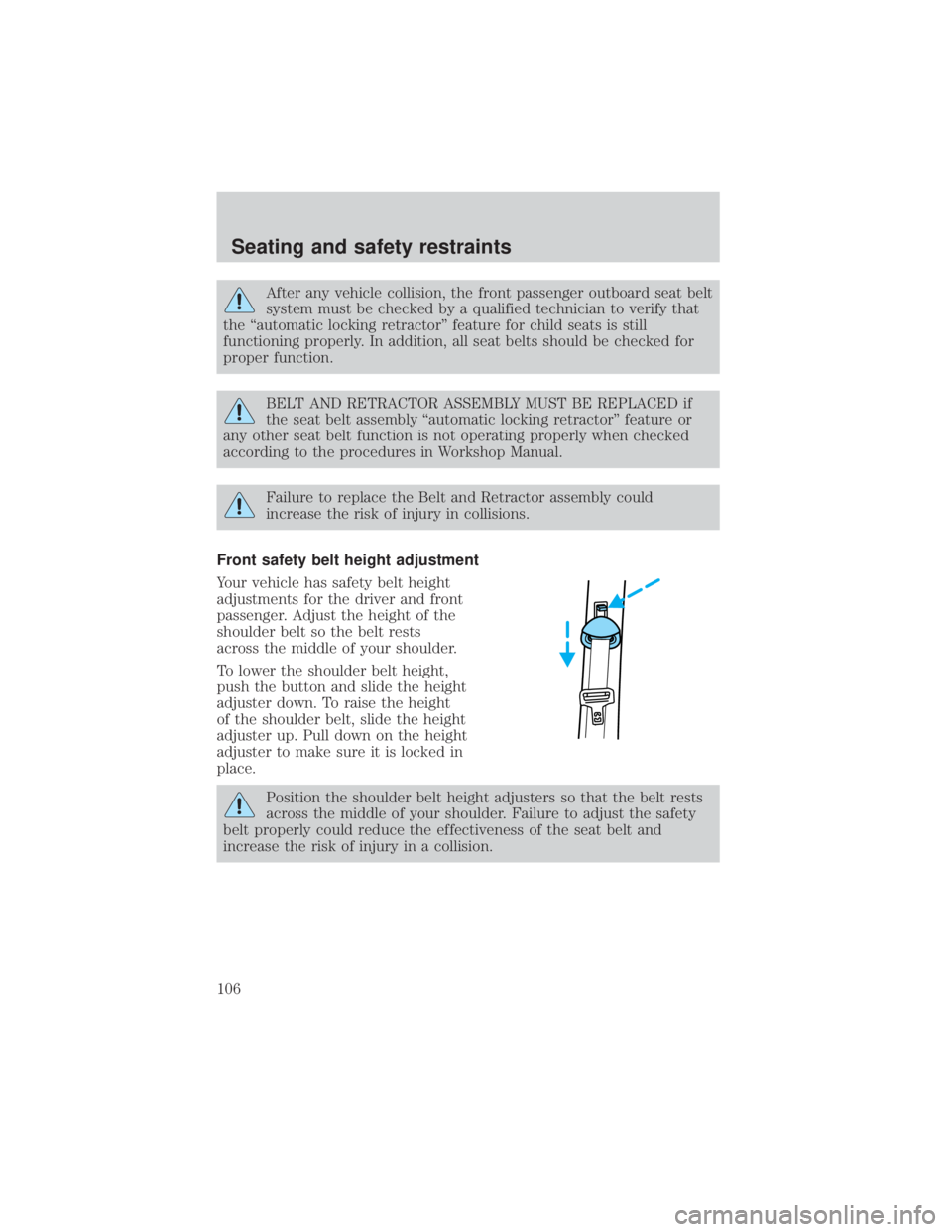Page 104 of 264

2. To unfasten, push the release
button and remove the tongue from
the buckle.
The front and rear outboard safety restraints in the vehicle are
combination lap and shoulder belts. The front passenger and rear seat
outboard safety belts have two types of locking modes described below:
Vehicle sensitive mode
The vehicle sensitive mode is the normal retractor mode, allowing free
shoulder belt length adjustment to your movements and locking in
response to vehicle movement. For example, if the driver brakes
suddenly or turns a corner sharply, or the vehicle receives an impact of
approximately 8 km/h (5 mph) or more, the combination safety belts will
lock to help reduce forward movement of the driver and passengers.
Automatic locking mode
In this mode, the shoulder belt is automatically pre-locked. The belt will
still retract to remove any slack in the shoulder belt.
The automatic locking mode is not available on the driver safety belt.
When to use the automatic locking mode
²Any timea child safety seat is installed in a passenger front or
outboard rear seating position (if equipped). Children 12 years old and
under should be properly restrained in the rear seat whenever
possible. Refer toSafety Restraints for ChildrenorSafety Seats for
Childrenlater in this chapter.
Seating and safety restraints
104
Page 106 of 264

After any vehicle collision, the front passenger outboard seat belt
system must be checked by a qualified technician to verify that
the ªautomatic locking retractorº feature for child seats is still
functioning properly. In addition, all seat belts should be checked for
proper function.
BELT AND RETRACTOR ASSEMBLY MUST BE REPLACED if
the seat belt assembly ªautomatic locking retractorº feature or
any other seat belt function is not operating properly when checked
according to the procedures in Workshop Manual.
Failure to replace the Belt and Retractor assembly could
increase the risk of injury in collisions.
Front safety belt height adjustment
Your vehicle has safety belt height
adjustments for the driver and front
passenger. Adjust the height of the
shoulder belt so the belt rests
across the middle of your shoulder.
To lower the shoulder belt height,
push the button and slide the height
adjuster down. To raise the height
of the shoulder belt, slide the height
adjuster up. Pull down on the height
adjuster to make sure it is locked in
place.
Position the shoulder belt height adjusters so that the belt rests
across the middle of your shoulder. Failure to adjust the safety
belt properly could reduce the effectiveness of the seat belt and
increase the risk of injury in a collision.
Seating and safety restraints
106
Page 255 of 264

instrument cluster lens ..........231
instrument panel ....................230
interior .....................................231
mirrors .....................................232
plastic parts ............................230
safety belts ..............................231
washing ....................................227
waxing .....................................228
wheels ......................................229
windows ..................................232
wiper blades ............................230
Climate control (see Air
conditioning or Heating) ............20
Clock ......................................35, 50
Clutch
fluid ..........................................189
operation while driving ..........140
recommended shift speeds ....141
Compass, electronic ....................65
calibration .................................67
set zone adjustment .................66
Console ........................................72
overhead ....................................63
Controls
power seat .................................98
Coolant
checking and adding ..............191
refill capacities ................195, 233
specifications ..................235, 238
Cruise control (see Speed
control) ........................................56
Customer Assistance ................158
Ford accessories for your
vehicle .....................................249
Ford Extended Service
Plan ..........................................241
Getting assistance outside the
U.S. and Canada .....................247Getting roadside assistance ...158
Getting the service
you need .................................241
Ordering additional owner's
literature .................................251
The Dispute Settlement
Board .......................................243
Utilizing the
Mediation/Arbitration
Program ...................................247
D
Daytime running lamps
(see Lamps) ................................18
Dipstick
automatic transmission
fluid ..........................................196
engine oil .................................185
Doors
door ajar warning .....................12
lubricant specifications ..........235
Driving under special
conditions ..........................146±147
mud ..........................................146
sand .........................................146
snow and ice ...........................147
through water .................146, 150
E
Emergencies, roadside
jump-starting ..........................174
Emission control system ..........218
Engine ........................................238
check engine/service engine
soon light ....................................8
cleaning ...................................229
coolant .....................................191
idle speed control ...................200
Index
255